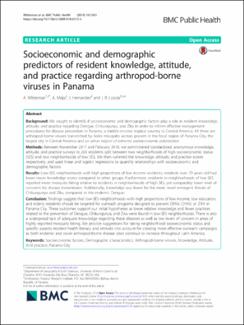| dc.contributor.author | Whiteman, Ari | |
| dc.contributor.author | Mejia, A. | |
| dc.contributor.author | Hernandez, I. | |
| dc.contributor.author | Loaiza, Jose R. | |
| dc.date.accessioned | 2020-07-03T02:02:47Z | |
| dc.date.available | 2020-07-03T02:02:47Z | |
| dc.date.issued | 2018-09-18 | |
| dc.identifier.other | https://doi.org/10.1186/s12889-018-6172-4 | |
| dc.identifier.uri | http://repositorio-indicasat.org.pa/handle/123456789/159 | |
| dc.description | Background: We sought to identify if socioeconomic and demographic factors play a role in resident knowledge, attitude, and practice regarding Dengue, Chikungunya, and Zika in order to inform effective management procedures for disease prevention in Panama, a middle-income tropical country in Central America. All three are arthropod-borne viruses transmitted by Aedes mosquito vectors present in the focal region of Panama City, the largest city in Central America and an urban region of extreme socioeconomic polarization.
Methods: Between November 2017 and February 2018, we administered standardized, anonymous knowledge, attitude, and practice surveys to 263 residents split between two neighborhoods of high socioeconomic status (SES) and two neighborhoods of low SES. We then summed the knowledge, attitude, and practice scores respectively, and used linear and logistic regressions to quantify relationships with socioeconomic and demographic factors.
Results: Low-SES neighborhoods with high proportions of low income residents, residents over 70 years old had lower mean knowledge scores compared to other groups. Furthermore, residents in neighborhoods of low SES reported more mosquito biting relative to residents in neighborhoods of high SES, yet comparably lower level of concerns for disease transmission. Additionally, knowledge was lower for the more novel emergent threats of Chikungunya and Zika, compared to the endemic Dengue.
Conclusion: Findings suggest that low-SES neighborhoods with high proportions of low income, low education, and elderly residents should be targeted for outreach programs designed to prevent DENV, CHIKV, or ZIKV in Panama City. These outcomes support our initial hypotheses as lower relative knowledge and fewer practices related to the prevention of Dengue, Chikungunya, and Zika were found in low-SES neighborhoods. There is also a widespread lack of adequate knowledge regarding these diseases as well as low levels of concern in areas of highly reported mosquito biting. We provide suggestions for taking neighborhood socioeconomic status and specific aspects resident health literacy and attitude into account for creating more effective outreach campaigns as both endemic and novel arthropod-borne disease rates continue to increase throughout Latin America. | en_US |
| dc.description.abstract | Background: We sought to identify if socioeconomic and demographic factors play a role in resident knowledge, attitude, and practice regarding Dengue, Chikungunya, and Zika in order to inform effective management procedures for disease prevention in Panama, a middle-income tropical country in Central America. All three are arthropod-borne viruses transmitted by Aedes mosquito vectors present in the focal region of Panama City, the largest city in Central America and an urban region of extreme socioeconomic polarization.
Methods: Between November 2017 and February 2018, we administered standardized, anonymous knowledge, attitude, and practice surveys to 263 residents split between two neighborhoods of high socioeconomic status (SES) and two neighborhoods of low SES. We then summed the knowledge, attitude, and practice scores respectively, and used linear and logistic regressions to quantify relationships with socioeconomic and demographic factors.
Results: Low-SES neighborhoods with high proportions of low income residents, residents over 70 years old had lower mean knowledge scores compared to other groups. Furthermore, residents in neighborhoods of low SES reported more mosquito biting relative to residents in neighborhoods of high SES, yet comparably lower level of concerns for disease transmission. Additionally, knowledge was lower for the more novel emergent threats of Chikungunya and Zika, compared to the endemic Dengue.
Conclusion: Findings suggest that low-SES neighborhoods with high proportions of low income, low education, and elderly residents should be targeted for outreach programs designed to prevent DENV, CHIKV, or ZIKV in Panama City. These outcomes support our initial hypotheses as lower relative knowledge and fewer practices related to the prevention of Dengue, Chikungunya, and Zika were found in low-SES neighborhoods. There is also a widespread lack of adequate knowledge regarding these diseases as well as low levels of concern in areas of highly reported mosquito biting. We provide suggestions for taking neighborhood socioeconomic status and specific aspects resident health literacy and attitude into account for creating more effective outreach campaigns as both endemic and novel arthropod-borne disease rates continue to increase throughout Latin America. | en_US |
| dc.language.iso | eng | en_US |
| dc.rights | https://creativecommons.org/licenses/by/4.0/ | |
| dc.rights | info:eu-repo/semantics/openAccess | |
| dc.subject | Socioeconomic factors | en_US |
| dc.subject | Demographic characteristics | en_US |
| dc.subject | Arthropod-borne viruses | en_US |
| dc.subject | Knowledge | en_US |
| dc.subject | Attitude | en_US |
| dc.subject | And practice | en_US |
| dc.subject | Panama City | en_US |
| dc.title | Socioeconomic and demographic predictors of resident knowledge, attitude, and practice regarding arthropod-borne viruses in Panama | en_US |
| dc.type | info:eu-repo/semantics/article | en_US |
| dc.type | info:eu-repo/semantics/publishedVersion | |

